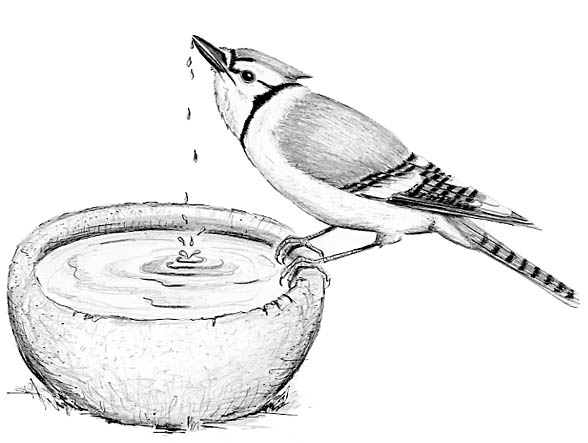
Dear Bird Folks,
One of the most active areas in my backyard is the birdbath. Birds of all kinds are always stopping by for a drink. You have reminded us several times that birds don’t have lips. With that in mind I have a straightforward question for you. Without lips, how are birds able to drink?
– Barbara, Wellfleet, MA
You are right, Barbara,
That is a straightforward question and it deserves a straightforward answer. Too bad you aren’t going to get one. Where would the fun be in that? If you want a straightforward answer you’ll have to read the owner’s manual of your car. No, wait. I take that back. Even owner’s manuals aren’t straightforward anymore. Recently it seems they write one manual that applies to about ten different vehicles. I’m constantly running across the phrase, “if your car is so equipped.” And no matter how much I spend, my car is never “so equipped.” I know this babble about cars seems out of place, but birds also aren’t all equipped the same way; thus they don’t do things, including drinking, the same way. So, like cars, there isn’t one simple, straightforward answer that applies to every bird. See? It all ties together.
Because birds come in all shapes and sizes and occupy every kind of habitat, it stands to reason that many have evolved different methods of drinking. Some birds need to drink everyday, while other birds never drink a day in their life. Some birds fly many miles in search of water, while other birds have their water delivered to them. Some birds only drink while on the wing, while others only need the water that is included with their meals. But they do have one thing in common: They are all smart enough not to spend a single cent on bottled water when free water will do the same job.
Just like you said, Barbara, birds don’t have lips. That’s why you never see a bird sucking on a straw, blowing bubbles or giving someone a raspberry. When, for example, a Blue Jay wants to drink, it must dip its bill into, say, a puddle, scoop up a bit of water into its lower bill, tilt its head back and let the water trickle down its throat. Without the sucking ability that lips provide, many birds depend upon gravity to do the job for them.
Not all birds need help from gravity, however. Even without lips, goofy doves and pigeons are able to suck up water. Using their tongue as a piston, they push the water back into their throats and can drink steadily without all the silly head tilting that many other birds need. An efficient moisture replacement system is important to doves and pigeons because they eat a lot of dry seeds and thus are heavy drinkers, which may explain why many of them sleep under city bridges at night.
Some birds have no time for tilting or sucking. Barn Swallows don’t bother landing when they are thirsty, but instead get all their drinks to go. When a swallow needs to wet its whistle, it heads over to the nearest pond and scoops up a beak-full of water as it flies just above the surface. Pelicans have one of the best, and most energy-efficient water, gathering systems. They basically sit and wait for the water to come to them. And when water does come to them, in the form of rain, they simply open up their massive bills and catch the falling rain. Of course, pelicans also get plenty of water while they are scooping up fish, but catching falling rain (which they really do) makes for a better story.
There are some birds that don’t understand what this drinking talk is all about because they may never take a drink throughout their entire lives. Hummingbirds fit into this category. A hummingbird’s diet consists of nectar, nectar, nectar, a tiny insect and more nectar. Since nectar is mostly water, the little hummingbird ingests plenty of liquid while it is feeding and doesn’t need to go looking for anymore. On the downside, the hummers frequently have to stop to use the restroom, which can be a problem, especially during migration.
Birds of prey also don’t have to go out of their way for water. They obtain most of their moisture needs from the creatures they eat, and thus rarely have to stop off for a drink. However, I once saw a Great-horned Owl land on the edge of a pond and help itself to several mouthfuls of pond water. This was a rare sight indeed. Perhaps the owl had just finished several Slim Jims and needed something to wash them down. It could happen.
I’m glad you mentioned that your birdbath is the most active area in your yard, Barbara. As birdseed prices climb higher it’s good that you have pointed out how attractive a source of water can be to birds. Just keep in mind that if you fill your bath with bottled water the birds will still come, but they’ll laugh at you, and well they should.